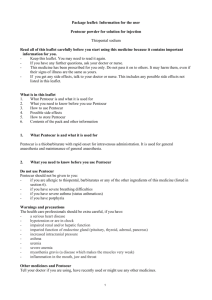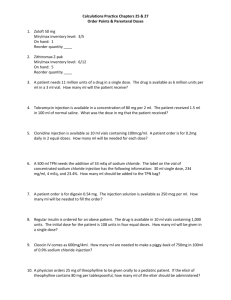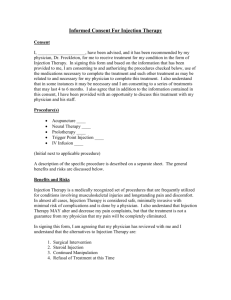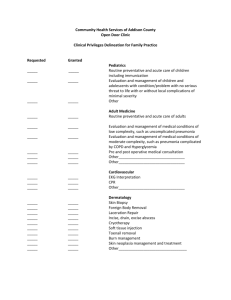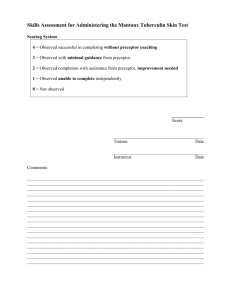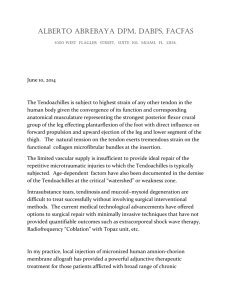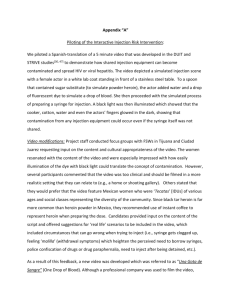Pentocur powder for solution for injection ENG SmPC
advertisement
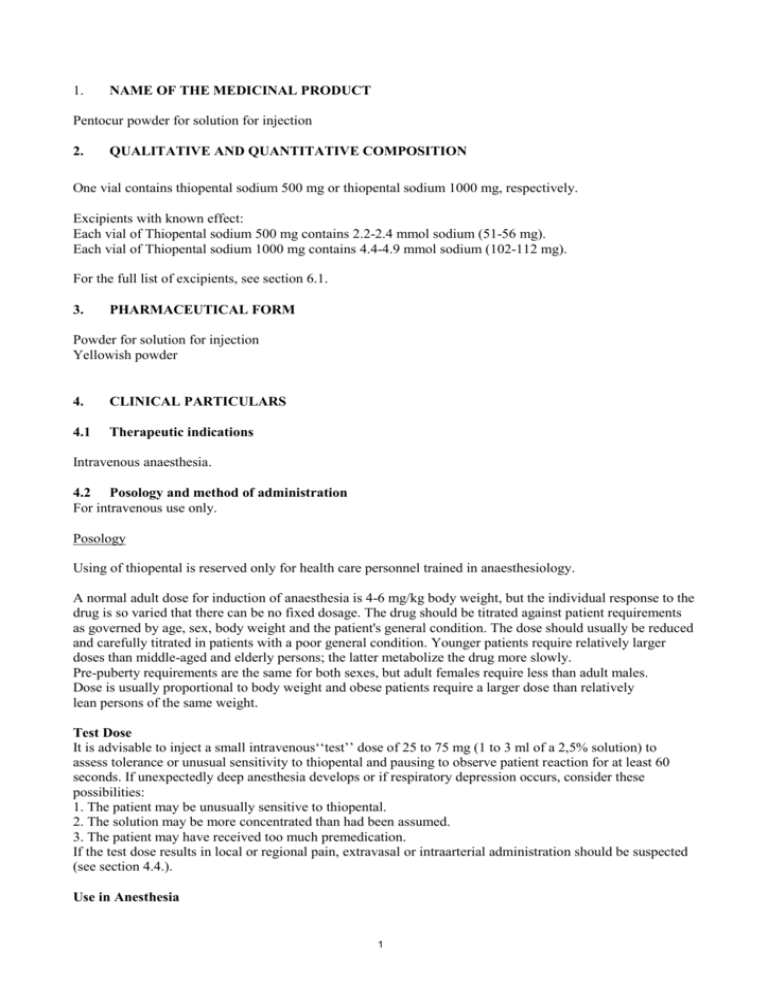
1. NAME OF THE MEDICINAL PRODUCT Pentocur powder for solution for injection 2. QUALITATIVE AND QUANTITATIVE COMPOSITION One vial contains thiopental sodium 500 mg or thiopental sodium 1000 mg, respectively. Excipients with known effect: Each vial of Thiopental sodium 500 mg contains 2.2-2.4 mmol sodium (51-56 mg). Each vial of Thiopental sodium 1000 mg contains 4.4-4.9 mmol sodium (102-112 mg). For the full list of excipients, see section 6.1. 3. PHARMACEUTICAL FORM Powder for solution for injection Yellowish powder 4. CLINICAL PARTICULARS 4.1 Therapeutic indications Intravenous anaesthesia. 4.2 Posology and method of administration For intravenous use only. Posology Using of thiopental is reserved only for health care personnel trained in anaesthesiology. A normal adult dose for induction of anaesthesia is 4-6 mg/kg body weight, but the individual response to the drug is so varied that there can be no fixed dosage. The drug should be titrated against patient requirements as governed by age, sex, body weight and the patient's general condition. The dose should usually be reduced and carefully titrated in patients with a poor general condition. Younger patients require relatively larger doses than middle-aged and elderly persons; the latter metabolize the drug more slowly. Pre-puberty requirements are the same for both sexes, but adult females require less than adult males. Dose is usually proportional to body weight and obese patients require a larger dose than relatively lean persons of the same weight. Test Dose It is advisable to inject a small intravenous‘‘test’’ dose of 25 to 75 mg (1 to 3 ml of a 2,5% solution) to assess tolerance or unusual sensitivity to thiopental and pausing to observe patient reaction for at least 60 seconds. If unexpectedly deep anesthesia develops or if respiratory depression occurs, consider these possibilities: 1. The patient may be unusually sensitive to thiopental. 2. The solution may be more concentrated than had been assumed. 3. The patient may have received too much premedication. If the test dose results in local or regional pain, extravasal or intraarterial administration should be suspected (see section 4.4.). Use in Anesthesia 1 Moderately slow induction can usually be accomplished in a healthy female or male adult weighing 60-80 kg by injection of 50 to 75 mg of thiopental at intervals of 20 to 40 seconds, depending on the reaction of the patient. Once anesthesia is established, additional injections of 25 to 50 mg can be given whenever the patient moves. Slow injection is recommended to minimize respiratory depression and the possibility of overdosage. The smallest dose consistent with attaining the surgical objective is the desired goal. Momentary apnea following each injection is typical, and progressive decrease in the amplitude of respiration appears with increasing dosage. Pulse remains normal or increases slightly and returns to normal. Muscles usually relax about 30 seconds after unconsciousness is attained, but this may be masked if a skeletal muscle relaxant is used. The tone of jaw muscles is a fairly reliable index. The pupils may dilate but later contract. Sensitivity to light is not usually lost until a level of anesthesia deep enough to permit surgery is attained. Nystagmus and divergent strabismus are characteristic during early stages, but at the level of surgical anesthesia, the eyes are central and fixed. Corneal and conjunctival reflexes disappear during surgical anesthesia. When thiopental is used as the sole anesthetic agent, the desired level of anesthesia can be maintained by injection of small repeated doses as needed or by using a continuous intravenous infusion with a 0.2% or 0.4% concentration (see section 6.6). For information on preparation of solutions see section 6.6. With continuous infusion, the depth of anesthesia is controlled by adjusting the rate of infusion. Paediatric population The doses are recommended for healthy paediatric population, and doses may have to be adjusted depending on for example concomitant illness, preanesthesia. Newborns IV 3 to 4 mg/kg then 1 mg/kg as needed Infants IV 5 to 8 mg/kg then 1 mg/kg as needed. Children IV 5 to 6 mg/kg then 1 mg/kg as needed. The suggested paediatric dosage categories are only indicative of required doses. Actual dosing must be individualized and titrated to effect based on age, maturity and the general condition of the paediatric patient. Method of administration Pentocur must only be administered by the intravenous route. Care should be taken to ensure intravenous administration (see section 4.4). For instructions on dilution of the medicinal product before administration, see section 6.6. 4.3 Contraindications Hypersensitivity to the active substance or to any of the excipients listed in section 6.1. Obstructive respiratory disease Status astmaticus. Known porphyria. 4.4 Special warnings and precautions for use Thiopental may cause addiction. A person qualified in the use of anesthetics should be constant available during the administration of the medicinal product. Keep endotracheal intubation equipment, oxygen and resuscitative equipment readily available. Caution must be taken in patients with severe heart-vascular disease, hypotension or in chock or under conditions in which the hypnotic effect may be prolonged or potentiated, as in case of excessive premedication, endocrine insufficiency (pituitary, thyroid, adrenal, pancreas), hepatic or renal dysfunction, increased blood urea, severe anemia or myasthenia gravis. 2 Caution must be taken in patients with increased intracranial pressure or asthma. If used under these conditions reduce dosage and administer slowly. Use in neurological patients with raised intracranial pressure Thiopental has been associated with reports of severe or refractory hypokalaemia during infusion; severe rebound hyperkalaemia may occur after cessation of thiopental infusion. The potential for rebound hyperkalaemia should be taken into account when stopping thiopental therapy. Caution must be taken in patients with potential airway compromise, such as conditions involving inflammation in the mouth, jaw and throat. Thiopental concentrations less than 2.0 % can cause hemolysis. Avoid extravasation or intra arterial injection (see also section 4.8). Extravascular infiltration: Extravascular injection should be avoided. Care should be taken to insure that the needle is within the lumen of the vein before intravenous injection of Pentocur. Extravascular injection may cause chemical irritation of the tissues varying from slight tenderness to venospasm, extensive necrosis and sloughing. This is due primarily to the high alkaline pH (10 to 11) of clinical concentrations of the drug. If extravasation occurs, the local irritant effects can be reduced by injection of 1% lidocaine locally to relieve pain and enhance vasodilatation. Local application of heat also may help to increase local circulation and removal of the infiltrate. Intra-arterial injection: Intra-arterial injection can occur inadvertently, especially if an aberrant superficial artery is present at the medial aspect of the antecubital fossa. The area selected for intravenous injection of the drug should be palpated for detection of an underlying pulsating vessel. Accidental intra-arterial injection may cause arteriospasm and severe pain along the course of the artery with blanching of the arm and fingers. Appropriate corrective measures should be instituted promptly to avoid possible development of gangrene. Methods suggested for dealing with this complication vary with the severity of symptoms. The following have been suggested (controlling investigations are missing): 1. Dilute the injected Pentocur by removing the tourniquet and any restrictive garments. 2. Leave the intravenous cannula in place, if possible. 3. Inject the artery with a dilute solution of papaverine, or lidocaine, to inhibit smooth muscle spasm. 4. If necessary, perform sympathetic block of the brachial plexus and/or stellate ganglion to relieve pain and assist in opening collateral circulation. Papaverine can be injected into the subclavian artery, if desired. 5. Unless otherwise contraindicated, treat with heparin to prevent thrombus formation. 6. Consider local infiltration of an alpha-adrenergic blocking agent such as phentolamine into the vasospastic area. 7. Provide additional symptomatic treatment as required. This medicinal product contains 2.2-2.4 mmol (or 51-56 mg) sodium per dose of 500 mg. This medicinal product contains 4.4-4.9 mmol (or 102-112 mg) sodium per dose of 1000 mg. To be taken into consideration by patients on a controlled sodium diet. 4.5 Interaction with other medicinal products and other forms of interaction Thiopental interacts with the following substances: aminophylline (thiopental antagonism), midazolam: (synergy), opioid analgesics (decreased sensibility to pain), probenecid (prolonged action of thiopental), sufentanile (decrease dosedependently the need of barbiturates at induction of anaesthesia. See section 6.2. Opioids potentiates the respiratory depressive effect. The effect is enhanced by alcohol, hypnotics, anxiolytics, antipsycotics and antihistamines. 3 Concomitant use of barbiturates and benzodiazepines, chloral hydrate or central acting muscle relaxants may result in an additive respiratory depression. Valproate and MAO-inhibitors inhibit the metabolism of barbiturate acid derivates with a risk of poisoning. Concomitant use of thiopental and metoclopramid may result in an increased hypnotic effect of thiopental. Concomitant use of barbiturates and quetiapin may result in a reduced serum concentration of quetiapin. Concomitant use of barbiturates and Hypericum performatum may reduce the CNS depression. Increased doses may be necessary in patients with alcohol- or narcotics misuse. Thiopental interacts with beta blockers and calcium antagonists and result in a blood pressure decrease. Barbiturates increase by enzyme induction the elimination of androgens, some antiepileptics, felodipin, glucocorticoids, metronidazol, peroral anticoagulants and estrogen and thereby decrease the plasmaconcentration of these substances. Barbiturates inhibit the hypoglycaemic effect of peroral antidiabetics (sulfonyl-urine substances). Barbiturates decrease the effect of theophyllin by enzyme induction. 4.6 Fertility, pregnancy and lactation Thiopental crosses the placental barrier easiliy. Animal reproduction studies have not been conducted with thiopental. Thiopental should not be given to a pregnant woman, unless the expected benefits clearly outweighs the risks. Thiopental is excreted to breastmilk. Therefore, breast-feeding should be temporarily suspended (at least 12 hours) and breast milk expressed before the induction of anaesthesia. 4.7 Effects on ability to drive and use machines Even though the recovery after use of Pentocur is rapid patients must not drive and use machines 24 hours after application or during the time period defined as necessary by the responsible physician. 4.8 Undesirable effects The frequencies of adverse events are ranked according to the following: Very common (≥1/10), common (≥1/100 to <1/10), uncommon (≥1/1,000 to <1/100, rare (≥1/10,000 to <1/1,000), very rare (<1/10,000), not known (cannot be estimated from the available data). Cardiac disorders Common: Heart arrythmia, myocardia depression, hypotension Nervous system disorders Common: Somnolence, delayed wakening Respiratory, thoracic and mediastinal disorder Common: Respiratory depression, bronchospasm, laryngospasm, coughing and snoring General disorders and administration site conditions Common: Shivering Rare: Anaphylactoid reactions (urticaria, bronchospasm, fall in blood pressure and angioedema). 4 Metabolism and nutrition disorders: Frequency not known: hypokalaemia, hyperkalaemia Immune hemolytic anemia with renal failure and paralysis of nervus radialis have been reported in rare cases. Reactions which may be caused by the diluent, preparation - or solving technique or by administration of prepared solutions with thiopenthal sodium include fever, venous thrombosis or phlebitis at the injection site, and events after extravasal injection. Reporting of suspected adverse reactions Reporting suspected adverse reactions after authorisation of the medicinal product is important. It allows continued monitoring of the benefit/risk balance of the medicinal product. Healthcare professionals are asked to report any suspected adverse reactions via the national reporting system listed in [To be completed nationally] 4.9 Overdose Overdosage may occur from too rapid or repeated injections. Too rapid injection may be followed by an alarming fall in blood pressure and chock. Apnea may occur in connection with too excessive or too rapid injections. Also laryngospasm, coughing and other respiratory difficulties may occur, but may also be a sign of under dosing (reflex induced). In the event of suspected or apparent overdosage, the drug should be discontinued. A patent airway should be secured. Oxygenation and ventilation should be monitored and supported as needed. The circulation should be monitored and supported as needed. 5. PHARMACOLOGICAL PROPERTIES 5.1 Pharmacodynamic properties Pharmacotherapeutic group: Barbiturates plan, ATC code: N01AF03 Pentocur is a thiobarbiturate with rapid onset for intravenous administration. Thiopental induces hypnosis and anesthesia, but not analgesia. Hypnosis is produced within 30 to 40 seconds. Recovery is within 30 minutes after adequate induction dose. Repeated injections give a prolonged anesthesia because of entry into fatty tissue. 5.2 Pharmacokinetic properties Thiopental is almost completely metabolized and only approximately 0.3 % is excreted unchanged in the urine. Thiopental is extremely fat soluble and is largely metabolized in the liver but is slowly excreted from lipid depot and is very slowly transformed. During one hour 10-15 % is metabolized, mainly in the liver. The half-life of the distribution phase after a single intravenous dose is 2-4 hours and the half-life of the elimination phase is 9-11 hours. 5.3 Preclinical safety data There are no preclinical data considered relevant to clinical safety beyond data included in other sections of the SPC. 6. PHARMACEUTICAL PARTICULARS 6.1 List of excipients Sodium carbonate 5 6.2 Incompatibilities Any solution of Pentocur powder for solution for injection, with a visible precipitate should not be administered. The stability of Pentocur powder for solution for injection solutions depends upon several factors, including the diluent, temperature of storage and the amount of carbon dioxide from room air that gains access to the solution. Any factor or condition which tends to lower pH (increase acidity) of Pentocur powder for solution for injection solutions will increase the likelihood of precipitation of thiopental acid. Such factors include the use of diluents which are too acidic and the absorption of carbon dioxide which can combine with water to form carbonic acid. Solutions of suxamethonium, tubocurarine or other drugs which have an acid pH should not be mixed with Pentocur powder for solution for injection solutions. The most stable solutions are those reconstituted in water and/or isotonic saline and/or solution of dextrose, kept under refrigeration and tightly stoppered. The presence or absence of a visible precipitate offers a practical guide to the physical compatibility of prepared solutions of Pentocur powder for solution for injection. 6.3 Shelf life Before first opening: 3 years After reconstitution: 24 hours in refrigerator (2-8 ° C) 6 hours in room temperature 6.4 Special precautions for storage Before first opening: The medicinal product does not require any special storage conditions. After reconstitution: Store in refrigerator (2-8°C) maximum for 24 hours. Store in room temperature maximum for 6 hours. Solutions of Pentocur powder for solution for injection must be prepared fresh and must be used rapidly. Solution unused in 24 hours must be disposed. Prepared solutions must not be sterilized with vapour. 6.5 Nature and contents of container Pure glass (hydrolytic class I or II) vial with bromobutyl stopper, aluminium seal, box. Pentocur powder for solution for injection 0.5 g: 1 x 1vial, 10 x 1vial, 20 x 1 vial and 50 x 1 vial Pentocur powder for solution for injection 1.0 g: 1 x 1vial, 10 x 1vial, 20 x 1 vial and 50 x 1 vial Not all pack sizes may be marketed. 6.6 Special precautions for disposal and other handling Preparation of solutions Pentocur powder for solution for injection is supplied as a yellowish, hygroscopic powder in a vial. Solutions should be prepared aseptically with one of the three following diluents: - Sterile Water for Injection (according Ph.Eur.), - solution for infusion of sodium chloride (9 mg/ml), - 5% dextrose solution for infusion. Clinical concentrations used for intermittent intravenous administration vary between 2.0% and 5.0%. A 2.0% or 2.5% solution is most commonly used. A 3.4% concentration in sterile water for injection is isotonic; concentrations less than 2.0% in this diluent are not used because they cause hemolysis. For continuous intravenous drip administration, concentrations of 0.2% or 0.4% are used. Solutions may be prepared by adding thiopental to 5% water solution of dextrose or to 0.9% solution of sodium chloride. 6 CALCULATIONS FOR VARIOUS CONCENTRATIONS Desired concentration Amounts to use % mg/ml g of Pentocur ml of diluent 0,2 2 1 500 0,4 4 1 250 2 500 2,0 20 5 250 10 500 2,5 25 1 40 5 200 5,0 50 1 20 5 100 Since Pentocur contains no added bacteriostatic agent, extreme care in preparation and handling should be exercised at all times to prevent the introduction of microbial contaminants. Solutions should be freshly prepared and used promptly; when reconstituted for administration to several patients; unused portions should be discarded after 24 hours. Sterilization by vapour should not be attempted. Any unused product or waste material should be disposed of in accordance with local requirements. 7. MARKETING AUTHORISATION HOLDER <To be completed nationally> 8. MARKETING AUTHORISATION NUMBER(S) <To be completed nationally> 9. DATE OF FIRST AUTHORISATION/RENEWAL OF THE AUTHORISATION 03 October 2012 10. DATE OF REVISION OF THE TEXT 02 June 2014 7
